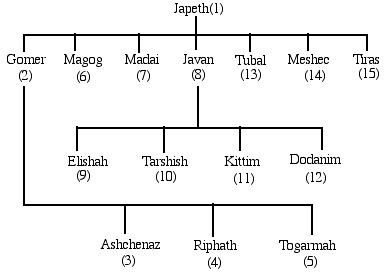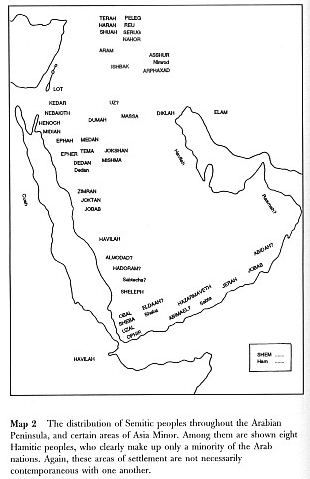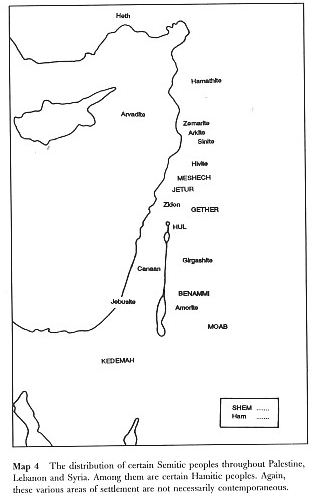
After the Flood - by Bill Cooper |
CHAPTER
I
CHAPTER II CHAPTER III CHAPTER IV CHAPTER V CHAPTER VI CHAPTER VII CHAPTER VIII CHAPTER IX CHAPTER X CHAPTER XI CHAPTER XII CHAPTER XIII |

After the Flood - by Bill Cooper |
CHAPTER
I
CHAPTER II CHAPTER III CHAPTER IV CHAPTER V CHAPTER VI CHAPTER VII CHAPTER VIII CHAPTER IX CHAPTER X CHAPTER XI CHAPTER XII CHAPTER XIII |
| << PREV |
Europe traced back to Noah" |
 |
1. Japheth: The father of all the Indo-European peoples, it
would be surprising indeed if his name had gone unremembered among them.
As it is, we find that the early Greeks worshipped him as Iapetos,
or Iapetus, whom they regarded as the son of heaven and earth, the
father of many nations. Likewise, in the ancient Sanskrit vedas of India
he is remembered as Pra-Japati, the sun and ostensible Lord of Creation.
As time went by, his name was further corrupted, being assimilated into
the Roman pantheon as Iupater, and eventually Jupiter (see
Appendix 11). None of these names are of
Greek, Indian or Latin origin, but are merely corruptions of the original
name of Japheth. Both the early Irish Celts and the early Britons traced
the descent of their royal houses from Japheth, as did also the early Saxons
who corrupted his name to Sceaf,--pr. 'sheaf' or 'shaif' (see chapter
7). (Refs: 1DB 2:802. NBD 599. JA 1.vi.1.
P 1:26)
Note: Appendix 3 - MAPS are here. |
2. Gomer: He was the founder of the Cimmerians who settled originally on the shores of the Caspian Sea. They were later driven away by the Elamites (see Shem 2). At the time of the Babylonian Exile, the Jews knew them as the tribes that dwelt in the 'uppermost parts of the north' (Ezekiel 38:6). The Assyrians referred to them as the Gimirraya. Esarhaddon (681-668 BC) records his defeat of the Gimirrai; whilst King Ashurbanipal tells us in his records of the Cimmerian invasion of Lydia (see Shem 5) in the days of the Lydian king Gugu around the year 660 BC (see Map 1). (Refs: 1DB 2:440. NBD 481. JA 1.vi.1)
3. Ashchenaz: The descendants of Ashchenaz first settled in what is today Armenia, although in later Jewish writings he was associated (with his father Gomer) with the Germanic races. Hence, Germanic Jews are still known as Ashkenazim. More immediately, the Assyrians tell us in their inscriptions of the Askuza, a tribe who allied themselves with the Mannai in a revolt of the 7th century BC, an event that is also mentioned in the Old Testament (Jeremiah 51:27). Indeed, it is in this statement that Jeremiah incidentally confirms the identity of the Ashkenazim with the Askuza. This name, the Askuza of the Assyrian records, later became the Skythai (Scythians) of Herodotus. Other early sources confirm their place of settlement to be the area later known as Pontus and Bythinia, where the peoples of Ashchenaz gave their name to the lake and harbour of Ascanius, and to the land of Ascania. Josephus tells us that they were subsequently known to the Greeks as the Rheginians (see Map 1). (Refs: 1DB 1:254. NBD 96. JA 1.vi.1. P 1:26)
4. Riphath: His descendants gave their name to the Riphaean mountains, which early cosmographers thought of as constituting the then northernmost boundary of the earth. Pliny, Melo and Solinus record the name of Riphath as that of the Riphaci, Riphaces and Piphlataci who were later known to history as the Paphlagonians, the descent and identification of which is confirmed by Josephus (see Map 1). (Refs: 1DB 4:100. JA 1.vi.1. P 1:26)
5. Togarmah: His earliest descendants settled in Armenia. We know from certain Hittite documents that in the 14th century BC, the then region of Tegarama, which lay between Carchemish and Haran, was sacked by the 'enemy from Isuwa', i.e. the enemy from beyond the Euphrates. The records of both Sargon II and Sennacherib mention the city of Til-gari-manu, the capital of Kammanu which lay on the border of Tabal (see 13). Til-gari-manu lay some thirty miles due east of present-day Malatya (it is known today as Gürün, anciently Gauraena), and was not finally destroyed until the year 695 BC. It was after the destruction of Til-gari-manu that the descendants of Togarmah became lost in obscurity. In line with the Assyrian policy of that time, the survivors were uprooted and transported to other lands within the Assyrian empire (see Map 1). The name was given as Thrugramma by Josephus. (Refs: 1DB 4:662. NBD 1285. JA 1.vi.1. P 1:26)
6. Magog: His immediate descendants were known as the Magogites, being later known to the Greeks as the Scythians, according to the testimony of Josephus. However, given the subsequent history of the peoples of Ashchenaz (see 3), who are far more certainly identified as the later Scythians (Gk. Skythai, and Assyr. Askuza), it is more likely that the early Magogites were assimilated into the peoples of Ashchenaz, thus making up merely a part of the Scythian hordes. The early Irish Celts traced their own lineage from Japheth through the line of Magog (see chapter 9 and Map 1). (Refs: 1DB 3:226. NBD 'Gog and Magog' 480-1 JA 1.vi.1. P 1:26)
7. Madai: His descendants were the Madaeans, who are better known to us as the Medes. The Assyrians recorded the name as Amada; the Greeks as the Medai; and the Old Persian inscriptions speak of them as the Mada. The earliest surviving reference to the Medes that is found in secular documents, appears in the inscriptions of Shalmaneser III, king of Assyria from ca 858-824 BC, in which he tells us that he invaded the land of the Medes to plunder them of their fine horses. Both Strabo and Herodotus confirm the fact that the Medes were of Indo-European (Japhetic) origin, and we know also that their language was of this group. After 631 BC, the Medes joined with the people of Askuza (or the Ashchenazim, see 3) and those of Gomer (the Cimmerians, see 2) in an attempt to throw off the Assyrian yoke (see Map 1). (Refs: 1DB 3:220. NBD 'Medes' 801-2. JA 1.vi.1. P 1:26)
8. Javan: The name of Javan's descendants appears in Assyrian documents as the Iamanu, where we are told that they engaged the Assyrians in a major sea battle during the reign of King Sargon 11 (721-705 BC). The Archaemenian inscriptions refer to them as the Yauna. Homer tells us in the Iliad that Iawones (Hebrew Iawan) was the progenitor of the Ionians (Gk. Iones), while the Hebrews knew the Greeks as the Jevanim (Iewanim). Pre-Islamic Arab cosmographers gave the name as Yuban (see Map 1). (Refs: 1DB 2:805. NBD 600. JA 1.vi.1. P 1:26)
9. Elishah: He was the ancestor of the Aeolians, his name being frequently referred to in Greek history and mythology. Two Greek cities were named after him, these being Elis and Elissus. Likewise, an entire area was named Elias in his memory. His name lies behind the origin of the term Hellenic, and there is every reason to believe that his name is also perpetuated in the Greek paradise, the Elysian Fields. The Armana tablets referred to his descendants as the Alashia, the Hittites knew them as the Alasiya, and the Egyptians as A-ra-sa. Josephus rendered the name as Elisa. The name also appears in the Ugaritic inscriptions (see Map 1). (Refs: 1DB 2:92. NBD 366, JA1. vi.l. P 1:26)
10. Tarshish: The father of the peoples of Tarshish, or Tartesis, who are thought by most to have settled in Spain. The Mediterranean Sea was once known as the Sea of Tarshish, and it is known that the Phoenicians built a class of vessel called a ship of Tarshish. (It was in one of these that Jonah tried to flee from Joppa in the 8th century BC.) Phoenician inscriptions found on Sardinia, and dating to the 9th century BC, mention Tarshish without, unfortunately, providing us with a positive identification of its geographical location. Josephus records the name as Tharsus, and tells that it used to be the name under which Cilicia was known, the chief and noblest city of which was Tarsus. However, for various reasons the identification is unlikely, and the matter remains unresolved. (Refs: 1DB 4:517. NBD 1239-40. JA 1.vi.1. P 1:26)
11. Kittim: This is a collective name of a people who are spoken of in the Old Phoenician inscriptions as the kt or kty, and who settled on the island of Cyprus. They were to give their name to the ancient Cypriot city of Kition (modern-day Larnaka). The Romans preserved the name when they named the city Citium, and Josephus gave the name as Cethimus. (Refs: 1DB 3:40-1. JA 1.vi.1. P 1:26)
12. Dodanim: This also is a collective name of a people descended from Dodan, who were known to the Greeks as the Dardani, the Dardanians of Asia Minor. They settled initially around the area of Troy whose coastal regions are known to this day as the Dardanelles. The founder of this people was deified by his descendants and worshipped under the name of Jupiter Dodonaeus. (Here we have a mingling of the names of Japheth and Dodan.) The propagators of this cult built the city of Dodona as the chief seat of his worship. Egyptian records refer to the drdny who were allied to the Hittites (see Ham 23) at the battle of Kadesh. The early Britons were to trace their descent from Dardanus (Appendix 7). (Refs: 1DB 1:861. NBD 321. P 1:26)
13. Tubal: The descendants of Tubal first come to our notice in the inscriptions of Tiglath-pileser I, king of Assyria in about 1100 BC. He refers to them as the Tabali whose original area of settlement (i.e. Tabal) was adjacent to that of Tegarama (see 5). Subsequently, Josephus recorded the name of Tubal's descendants as the Thobelites, who were later known as the Iberes. Their land, in Josephus' day, was called by the Romans Iberia, and covered what is now the (former Soviet) state of Georgia whose capital to this day bears the name Tubal as Tbilisi. From here, having crossed the Caucasus mountains, this people migrated due north-east, giving their tribal name to the river Tobol, and hence to the famous city of Tobolsk. (Refs: 1DB 4:717. NBD 'Meshech' 811. JA1. vi.1)
14. Meshech: The descendants of Meshech are often spoken of in close association with those of Tubal, the Assyrians for example mentioning Tabal and Musku, whilst Herodotus writes of the Tiberanoi and Moschoi. A very much earlier reference to the peoples of Meshech, is an inscription of ca 1200 BC which tells us how they overran the Hittite kingdom; and an inscription of Tiglath-pileser I of Assyria from ca 1100 BC, who tells us that, in his own day, the Mus-ka-a-ia were able to put into the field an army of 20,000 men. The activities of this same people are also subsequently reported by Tukulti-ninurta II, Ashurnasipal II, Sargon and Shalmaneserr III, the last of whom refers to them as the Mushki. Josephus knew them as the Mosocheni (LXX Mosoch), whom, he says, were known in his own day as the Cappadocians. Some later writers have pointed out that the name of Meshech is preserved in the old tribal name of the Muscovites of Russia, after whom Moscow is named. Such an identification, it must be said, is not at all unlikely, especially when we consider the subsequent history of their historically close associates the people of Tubal, and the fact that the city is still known today in the Russian tongue as Moskva, an exceedingly close, not to say identical relationship to the Assyrian form, Musku. (Refs: 1DB 3:357. NBD 811. JAl. vi.l. P 1:26)
15. Tiras: Merenptah of Egypt, who reigned during the 13th century BC, provides us with what is so far our earliest reference to the people of Tiras, recording their name as the Tursha (or Turusha), and referring to them as invaders from the north. The Greeks later knew them as the Tyrsenoi, a nation of marauding pirates. Josephus identifies them as the tribe who were known to the Romans as the Thirasians, and who we now know as the Thracians. They were a 'ruddy and blue-eyed people', who spent most of their time in state of 'tipsy excess', as one authority put it! Tiras himself was worshipped by his descendants as Thuras (i.e. Thor), the god of war. The river Athyras was named after him, and it is not at all unlikely that the Etruscans, a nation of hitherto mysterious provenance, owe to him both their name and descent. The ancient city of Troas (Troy) appears to perpetuate his name, as does also the Taurus mountain range. (Refs: 1DB 4:652. NBD 1283. JA 1.vi.1. P 1:26)
Appendix 3 - MAPS




| << PREV |
|
|